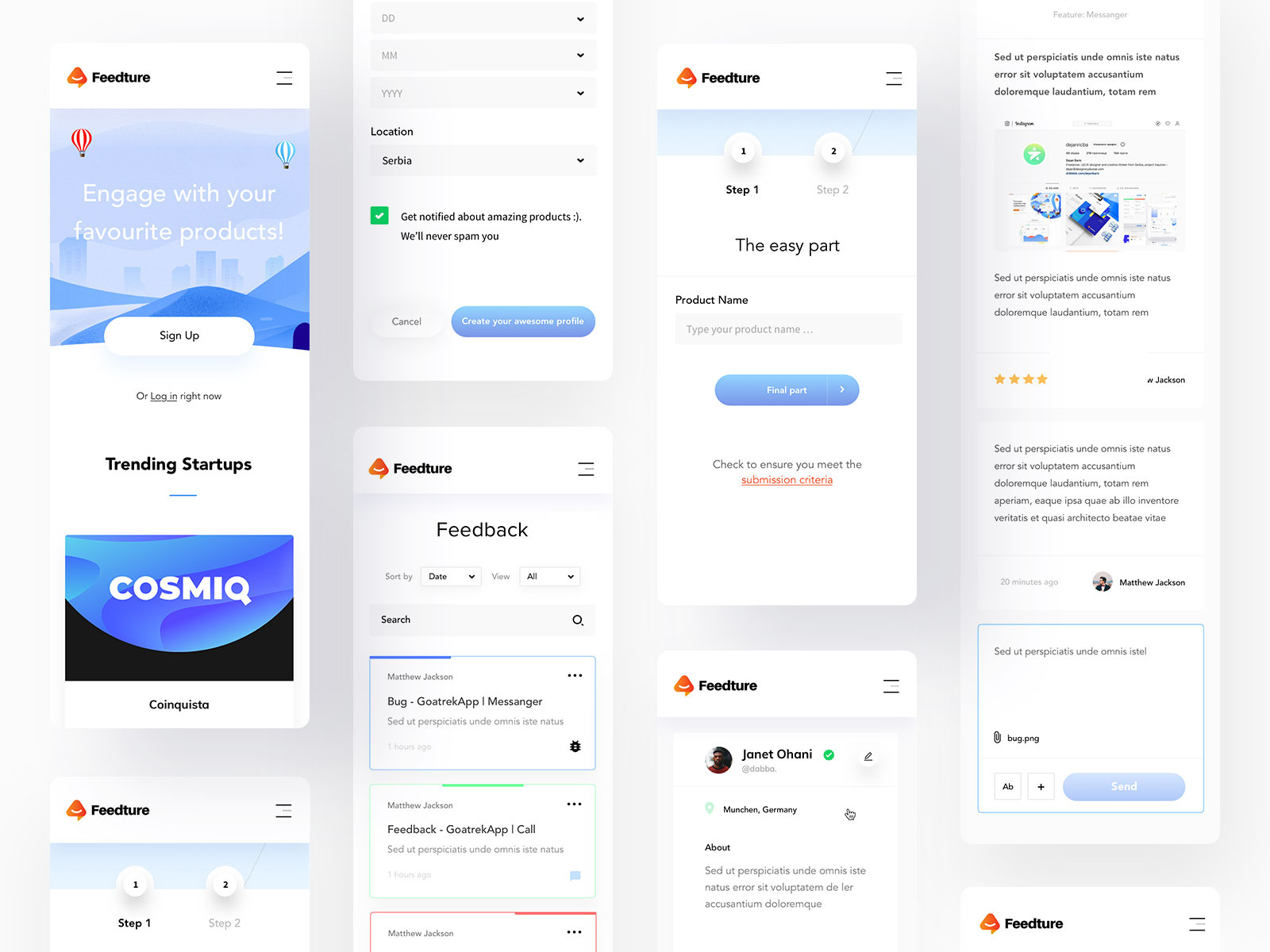Table Of Content

Stephen Gay is the UX Lead of Google AdWords, and he recommends that you choose your design role based on your passion and skills. Lastly, ongoing feedback from real-world use after product launch can offer additional insights into the UX design’s effectiveness over time. Continuous improvement based on this feedback can lead to lasting success. Regularly review project progress and adjust as necessary, and ensure that changes don’t derail the project's timeline or budget. If you adopt these strategies, you can tackle the prevalent challenges in UX design and enhance the overall effectiveness of your projects. For example, Spotify's UX design process features the use of personalized content recommendations ("Recommended" in the center of this screenshot).

Low fidelity vs. high fidelity: the differences between design prototypes
The “UI” in UI design stands for “user interface.” The user interface is the graphical layout of an application. It consists of the buttons users click on, the text they read, the images, sliders, text entry fields, and all the rest of the items the user interacts with. This includes screen layout, transitions, interface animations and every single micro-interaction.
Common Mistakes UI/UX Designer Do
The exact aesthetic they choose is up to them, but the basic “rules,” or the need to conform to user expectations, is something designers ignore at their own risk. It’s important for both disciplines to gather as much good information as possible to assist them in crafting appropriate designs, and both follow a similar approach. To do their job, and to provide an accurate solution, designers must first understand the underlying problems. Generally, UX and UI designers get paid almost the same, so it’s a matter of which role you prefer. As we mentioned, you might see a position for “UI/UX designer,” so you may find yourself doing both at some point.
The complete guide to Lean UX
The goal of UX design is to create easy, efficient, relevant, and all-around pleasant experiences for the user. Both UI and UX design are crucial aspects of a product design process, and they work together to create a successful product. “A UI without UX to a painter randomly smearing paint on a canvas, and UX without UI to an empty sculpture frame,” stated Rahul Varshney, one of the foster.fm co-founders. A UX designer’s job is to ensure that a user’s journey toward solving a problem is smooth and straightforward. They conduct extensive user research to identify the target users and their needs in relation to a product. UI designers use specialized UI design software like Visily, Sketch, Figma, and Adobe XD to create wireframes and prototypes, as well as mockups for their designs.
Get to know what is UX design and what is a typical day for a UX designer. Or read Kylie’s story of how she transitioned out of the hospitality industry to become a UX designer. According to a study conducted by the Design Management Institute, design-driven companies consistently outperformed the S&P 500 by 219% over a 10-year period. If you’re already ready to get your hands dirty, you can try out our free 5-day short course. Kate Conrick’s thought-provoking article on UX roles, aptly titled “We need to talk about UX roles”.
Additionally, it’s imperative that UX designers understand UI and vice versa. UX encompasses all the experiences a person has with a product or service, from beginning to end. UI design is specific to the individual means by which people interact with a product or service. Simply put, user experience design is the process of planning the experience a person has when they interact with a product. UX stands for “user experience,” and UI stands for “user interface.” You’ll often see them lumped together as they are two closely related professions that often work hand-in-hand. UX design can also be implemented in a way that aligns with business goals and objectives.
After launching a project
It provides a peek into different UX design careers and the design thinking process. By completing the Google UX Design Professional Certificate, available through Coursera, you can equip yourself with the job-ready skills you’ll need for an entry-level role in UX design. Research might indicate that people prefer outlined icons instead of bold shapes. This is a visual shorthand that people are comfortable with and enjoy.
If you're drawn to understanding human behavior, enjoy problem-solving, and have a knack for analytical thinking, a path in UX might suit you well. On the other hand, if your passion lies in creating interactive elements and optimizing how they work together to benefit users, UI could be your calling. Much like an iceberg, visual design is only the surface of user experience.
Is UX / UI a good career?
You can use Figma's readymade templates with simple drag-and-drop features to craft flowcharts, wireframes, prototypes, and more. To reinforce the brand identity of Homeschooling Kak Seto, I’ve opted to make blue the predominant color in design elements. This decision stems from the belief that blue symbolizes trust and stability, while also being easy on the eyes, thereby fostering a welcoming and enjoyable experience for users. We conducted foundational research to establish the groundwork for understanding our users’ needs. Our goal was to determine precisely what the users require and how to fulfill those needs effectively with our product.
These designers specialize in developing the visuals and interactive elements for everything from app icons to buttons and color schemes. They work in various industries, including tech companies, design agencies, and freelancing. Overall, UI design is a rewarding and fulfilling career for those dedicated to enhancing user experiences and creating visually appealing interfaces.
What is UX design? Here's everything you need to know - Fortune
What is UX design? Here's everything you need to know.
Posted: Mon, 08 Jan 2024 08:00:00 GMT [source]
UI design is a craft where you the designer build an essential part of the user experience. One analogy is to picture UX design as a car with UI design as the driving console. A UX designer’s primary goal is for each user to have a positive interaction with a product or service. Whether the interaction solves a problem, provides entertainment, or helps the user find critical information, the experience should leave the user feeling fulfilled. Testing prototypes on real users allows businesses to identify any design flaws before they invest in creating the final product. Note that several rounds of testing might have to take place before the design is spot on.
However, UX design is focused more on the user’s journey and solving his problem. On the other hand, UI is focused on a product’s tangible elements — how its surfaces look and function in order to complete the task (the saddle, etc). Once the UX team has finished their process and hands over a wireframe, UI Designers are in charge of designing how the product is laid out visually.
These heuristics have been reflected in many of the products designed by some of the most successful companies in the world such as Apple, Google, and Adobe. Further evidence of how their design teams incorporate these rules into their design process is reflected in the user interface guidelines published and shared by these companies. This article will teach you how to follow the ten rules of thumb in your design work so you can further improve the usability, utility, and desirability of your designs. UI design, on the other hand, refers to the actual interfaces with which users engage. The UI design process may include buttons or widgets, text, images, sliders, and other interactive elements.
Others may focus on service design, which concerns itself with designing an overall experience, such as a guest stay at a five-star hotel. UI designers are focused on visual touchpoints that let users interact with a product. This can include typography, color palettes, buttons, animation, and other imagery. Think about all the things you might do on an app – slide to delete, pull down to refresh, enter text, etc. All of these visual elements or animations that allow you to interact with the app must be designed.
For instance, you cannot create your UX portfolio without first knowing which UX role you want to target. Likewise, you need to know which job role you’re aiming for in order to sign up for courses that can teach you those exact skills and knowledge. In essence, service design sets the stage for UX design by defining the context and scope of the user interactions that UX designers will then refine and optimize. Both are crucial in creating a seamless and satisfying user experience. Together, they ensure that they consider every aspect of the user's journey and design it to be as intuitive and enjoyable as possible. The main goal of service design is to ensure that service interfaces are efficient, usable and meet user needs.









